Tulips are wonderful, long-lasting flowers that can be grown in one's own backyard. After the blooming season, tulip bulbs can be stored carefully, and replanted the next fall during the flowering season. Let's find out how to store these bulbs ...

Tulips originated in Turkey and the word 'tulip' comes from the Turkish word,
tulbend, meaning turban. This is because tulips resembled the turbans worn in Turkey at that time. Tulips, although classified along with perennials, have to be treated as annuals. They need well-drained soil and to improve the drainage, one can add sand and compost to the soil.
Once the foliage has died, the tulip bulbs are to be dug out and stored in a cool area. Then, they are to be replanted in the fall. Storing tulip bulbs is a great means of keeping the bulbs from blooming for several years to come. Once the tulips finish blooming, they begin to recharge themselves, for the next flowering season and start storing energy. After the recharging process is complete, the tulip bulbs lay dormant and wait to bloom afresh in the next season.
How to Store Tulip Bulbs for Fall Planting?
Storing tulips bulbs is a simple task, but has to be done carefully, so that they will be ready to be planted in the fall. There are different ways in which you can store them.
In-ground Storage: Since tulip bulbs are quite hardy, they can be easily stored in the ground. In fact, storing them in the ground is the easiest and (as considered by some) the laziest way to store these bulbs. However, if these tulip bulbs freeze in the soil, then they die, which is why the climate of the region plays a crucial role in determining the way in which bulbs are stored. One can check with the hardiness zone to see if they can be stored in the ground. If the environment is suitable to store the bulbs, then, one can go about with in-ground storage.
However, bulbs stored in the ground, need to be protected from squirrels, who are prone to sniffing them out. The only way to protect the bulbs from the squirrels is by covering the ground with a wire mesh. The mesh will prevent the squirrels from digging the bulbs out and the holes in the mesh will permit the tulips from sprouting in the following spring. Another drawback of this storage method is that in modern gardens, tulips are often mixed with other plants, which bloom later in the year, causing the tulips to be over-watered during their dormant months. Over-watering not only hinders the tulip's growth, but also leads to bulb rot.
Above-ground Storage: The best part about storing tulip bulbs above the ground, is that one can see the bulbs and divide them if possible. People planning to store tulip bulbs should wait for the tulip foliage to turn yellow. Yellowing implies completion of energy storage for the next year's blossoming season. If the bulbs are removed early, they won't have enough strength to grow in the following season but once the yellow indicator comes on, one can safely remove the bulbs from the ground. To prevent bulb rotting, clean off dirt and debris from the bulbs. Next, wash the bulbs and allow the bulbs to dry out in the sun for a week.
A layer of vermiculite, dry sand, or peat moss is to be spread at the bottom of a flat tray or container without a lid. Into this dry container, the bulbs are to be neatly placed, all the while ensuring that each bulb is covered by the sand-peat moss mixture. To store each bulb separately, one could use a styrofoam egg carton, or keep them in the segments of a cardboard box. The peat moss-sand mixture must be only one layer thick, for air circulation. This step is called packing of the tulip bulbs.
After packing, the next step is to keep the tulips in a cool, dark, well-ventilated area. Damp places can cause the bulbs to rot. Although moisture results in rotting, keeping the bulbs in dry places can cause them to dry out completely. Thus, the place chosen should ideally have average humidity, with the temperature being below 50ºF.
Storing these bulbs in the refrigerator is also not such a good idea. This is because certain fruits and vegetables release ethylene gas that can harm the bulbs. If one has a spare refrigerator, then one can go ahead with the refrigerator storage method. Mice, squirrels, chipmunks, and other rodents and pests love to get their hands or rather claws on these bulbs and feast on them. One should choose a location that is inaccessible to these bulb thieves.
By following these simple guidelines one can prepare to harvest lovely tulips in spring. Taking care of tulips is not difficult and proper care yields glorious flowers. Damaged bulbs can recover, however, it is advisable to store the damaged bulbs separately, so as to ensure the safety of the healthy ones. Don't forget to replant the bulbs the next fall!






 Tulips originated in Turkey and the word 'tulip' comes from the Turkish word, tulbend, meaning turban. This is because tulips resembled the turbans worn in Turkey at that time. Tulips, although classified along with perennials, have to be treated as annuals. They need well-drained soil and to improve the drainage, one can add sand and compost to the soil.
Tulips originated in Turkey and the word 'tulip' comes from the Turkish word, tulbend, meaning turban. This is because tulips resembled the turbans worn in Turkey at that time. Tulips, although classified along with perennials, have to be treated as annuals. They need well-drained soil and to improve the drainage, one can add sand and compost to the soil.